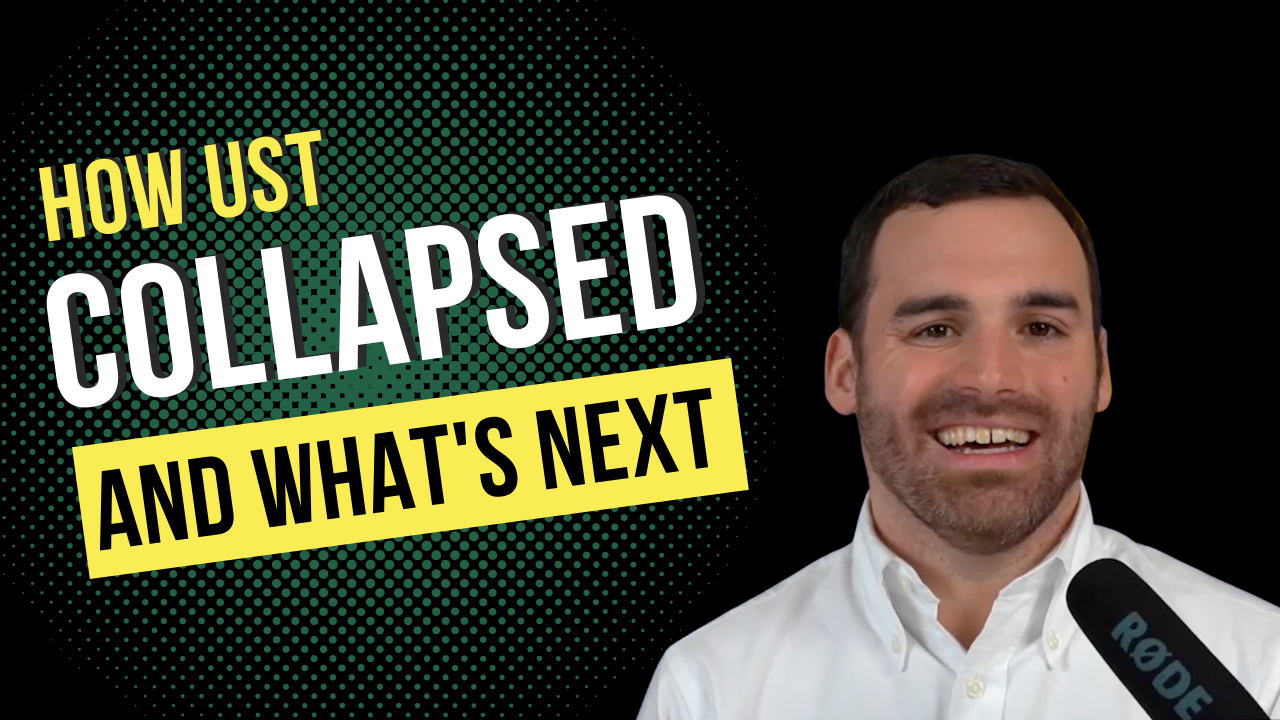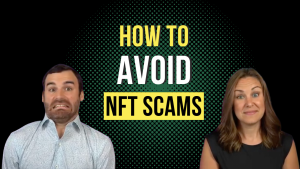Cryptogic provides tools, information, and commentary focused especially on cryptocurrencies, financial and cryptocurrency markets, economic trends, and trading strategies; these tools, information, and commentary are provided for general information purposes only. Neither Cryptogic nor any of its owners or employees are financial planners, investment advisors, or broker-dealers in any jurisdiction. Cryptogic does not provide investment advice, investment services, legal advice, legal services, tax advice, or tax services. Cryptogic does not contain, or constitute, and should not be interpreted as legal advice or opinion. Cryptogic is not a substitute for professional investment advice, tax preparation or legal advice. Consult an investment, tax or legal professional for specific advice about your situation. Click here to read our Website Terms of Use.
How UST Collapsed And What’s Next

The cryptocurrency world was recently rocked by the collapse of Terra (LUNA), and the depegging of Stablecoin TerraUSD from the dollar. Scott breaks down the what, why, and how of the event, and its future implications for crypto investors.
Watch On YouTube
Episode Highlights
How a Trash-Talking Crypto Founder Caused a $40 Billion Crash: “The downfall of Luna and TerraUSD offers a case study in crypto hype and who is left holding the bag when it all comes crashing down. Mr. Kwon’s rise was enabled by respected financiers who were willing to back highly speculative financial products. Some of those investors sold their Luna and TerraUSD coins early, reaping substantial profits, while retail traders now grapple with devastating losses.” (New York Times)
What Is LUNA and UST? A Guide to the Terra Ecosystem: “In the Terra ecosystem, users can always swap the LUNA token for UST, and vice versa, at a guaranteed price of $1 – regardless of the market price of either token at the time. This is important to note because it means if demand for UST rises and its price rises above $1, LUNA holders can bank a risk-free profit by swapping $1 of LUNA to create one UST token (which due to a rise in demand in this example, is worth more than $1).” (CoinDesk)
Stablecoins Are Crypto’s Killer App So Far – Just Not Terra: MakerDAO lead developer MacPherson agreed that Terra’s design was reckless, “pretty much from the start.” UST’s implosion emphasized the need for stablecoins to be collateralized, MacPherson said. It’s why MakerDAO chose to overcollateralize its stablecoin DAI (currently by 164%), “so that users can be certain they can always trade DAI for a dollar.” (Blockworks)
Crypto’s meltdown refocuses regulator attention on the industry: Treasury Secretary Janet L. Yellen told lawmakers last week that UST’s fate underscored the need for them to authorize banklike requirements for stablecoin issuers, along the lines of what a Treasury-led panel of regulators recommended last fall. But a Treasury senior official said regulators won’t necessarily wait for lawmakers to act. “In the absence of congressional action,” this official said, speaking on the condition of anonymity to offer a candid assessment, last week’s volatility “will put regulators and stakeholders on a stronger footing if they feel the need to act alone to mitigate the risks.” (Washington Post)
Today’s Cryptocurrency: TerraUSD (UST)
About The Show
Cryptogic is the show for crypto investors who are focused on long term results. Follow host Scott as he explores the investable world of blockchain technologies, Bitcoin, Ethereum, and other cryptocurrencies.
Connect With Cryptogic
- Watch Cryptogic on YouTube
- Listen to Cryptogic on Apple Podcasts
- Listen to Cryptogic on Google Podcasts
- Listen to Cryptogic on Spotify
- Follow Cryptogic on Twitter
Transcript
Scott: Hey, I’m Scott. And welcome to Cryptogic. Today, we are going to be talking about the collapse of U.S. Terra, the stablecoin, what that means for stablecoins themselves, the larger cryptocurrency ecosystem, and really covering what happened, and how did it happen?
I’m going to try to keep it not too, too technical, but I think it’s important to understand that something huge happened, and there’s a reason why, and this will have implications on the future of cryptocurrency. And before I get into this, you know, unfortunately, a lot of folks lost a lot of money, and that is just a terrible thing.
It is not something to be taken lightly, but it is something that we can learn from as we go forward. And that’s what I’m going to hope to do today. So, with that said, let’s start. What is UST? What happened with Terra and Luna? So, for those who are unfamiliar, programmer and entrepreneur, Do Kwan, who’s educated at Stanford, founded Terra…Terraform Labs, rather, back in 2018 in Seoul, South Korea.
And it was a ambitious blockchain project that would have tokens associated with it and that would really serve to be a development platform for DeFi projects and products as well as stablecoins, not just pegged to the U.S. dollar, but pegged to multiple currencies around the world.
And this project was different in that it didn’t have a proof of work, it had a proof of stake. So, it was, again, attempting to deal with some of the inefficiencies and issues of scale that some of the other projects have, like when we talk about Ethereum blockchain, for example.
And that was the idea. So, Do Kwan himself, kind of looking over here, he’s… Here’s the headline from The New York Times, “How a trash-talking crypto founder caused a $40 billion crash.” And trash-talking is, I think, an apt way to describe him. He’s very active on social media and Twitter, specifically, constantly talking about his project, how it’s going to the moon, all of the great things they’re doing, and really being that cheerleader for what they were doing.
And he was quite successful with it. You know, when you look at Terra, the platform, actually, the market capitalization, and this was as of March, had a market capitalization theoretically of about $34 billion. So, really, and one of the largest stablecoins out there, top five.
So, a tremendous amount of capital had flowed into this project and into Terra and Luna, and really, they were on top of the world in a lot of ways. So, what happened? Well, going through here, we look at what happened and really why their ecosystem is what it is.
So, TerraUSD was risky even by the standards of experimental crypto technology. So, unlike the popular stablecoin that you may be familiar with, Tether, it is not backed by cash, or fully collateralized, or treasuries, or other traditional assets. It actually derived its stability or suppose its stability from algorithms that linked its value to Luna, which is another cryptocurrency.
And the idea is that this would use this sort of algorithmic stable coin to if one was to drop in value, because you want to have a stable coin pegged to the U.S. dollar, if one were to drop in value, then the algorithm would kick in and the ecosystem would naturally, through arbitrage, have it prop it up because then more would go into Luna, or if UST went, you know, and the other way around, or if Luna went down, then more were flown into UST, and this way, you would keep that peg.
And the peg, when we’re talking about stablecoins, is so, so critical. This essentially is why a stablecoin exists, it’s because it’s pegged to the U.S. dollar, and it’s why it has its functionality. So, either way you cut it, it was risky. It was different than how normally stablecoins had been operating.
And it was ambitious. And there was a lot of criticism there. There was a research paper that was published by the University of Calgary, and it found that algorithmic stablecoins, and I’m quoting directly here “are inherently fragile and they are not stable at all, but exist in a state of perpetual vulnerability.” And the Federal Reserve’s bank research about the stablecoin market pointed out that the design flaws might lead to de-pegging, again, that is losing that peg to the one-to-one U.S.
dollar value, which is catastrophic. So, when we look at the collapse, what happened? Well, roughly on Saturday, May 7th, the trading price of UST went to about 88 cents and it stayed there longer.
I’m sorry, 98 cents, rather. It went to 98 cents. And it stayed there longer than arbitrage theory thought it would. So, this was the first test. And essentially what happened, and there’s a lot of discussion and disagreement out there about what exactly happened, were there whales, was there a lot of money that was moved to try to profit off of this?
Or, what I think, was this just a fact of general panic and a bank run happening because we entered this uncharted territory. And essentially, it was the equivalent of a money market fund breaking the buck. And large quantities, we’re talking billions of dollars of UST were taken off of various protocols.
So, this was the beginning of the run. And you can see here when you’re looking at the chart. Essentially, this is about when that happened. We were talking…So, it started to fall here, and then we’re talking about May 7th right here, and then it just completely collapsed as everyone pulled their money out of it. And then, remember I mentioned collateralized.
So, Terra was not fully collateralized. They had made some moves to try to back up their currency in the event of something like this so that if the price was falling, they could make some trades and prop it up and prevent the disaster from happening.
And they did this by acquiring more than $3 billion in Bitcoin. And the idea was the idea to prevent that, but it was too little too late. And, again, the problem was more fundamental. It was how it was designed. And once you have that run, there was nothing to back it up, and you had what we saw here.
So, that’s essentially what happened when you have Terra. And then, of course, there was also, Luna. And, again, that’s part of this arbitrage of kind of propping up…each of them propping the other up and keeping that peg. When you have that loose, that value, it was game over. And then kind of to speak again to the collateralized nature, MakerDAO lead developer, McPherson, agreed that Terra’s design was reckless “pretty much from the start.”
So, pretty much from the start. Again, a ticking time bomb here from Blockworks. And UST’s implosion emphasized the need for stablecoins to be collateralized. So, when you’re looking from an investment standpoint, you have to realize that if you’re looking at a stable coin and it is not collateralized, proceed with caution.
And if it is something that has this sort of new, you know, arbitrage whole backing, that really, really does present itself with a lot of risks. And, unfortunately, as we’ve seen in crypto, a lot of folks don’t understand the risk of these products before investing and they go too hard in and they don’t think about the nature of these, that it’s not necessarily…
You know, those yields are exciting, but you have to look at what’s behind the yield, you have to look at what is really going on, and at least understand some of the technology, some of the mechanisms, take a look at that white paper because if you don’t, then something like this happens, you can have some tremendous losses that are really, really unfortunate.
So, that’s essentially what happened. Again, going back to the price here, and we’re looking at one day. Or, actually, let’s go ahead and look at three months, you can see, you know, Terra’s value is essentially worthless, especially when you’re looking at it and when you think about it as something that’s supposedly a stablecoin and pegged to the U.S. dollar. It’s clearly not.
It is not worth… You know, one of them is worth a fraction of the U.S. dollar right now. And there’s a lot of lessons to be had here. Again, that collateralization is one that I would emphasize most of all, but also, I would emphasize the idea of understanding the mechanisms behind this and proceeding with caution. So, then it becomes, well, what’s next?
What does the future hold? And the first thing that the future absolutely holds is regulation. This is such a tremendous amount of capital to evaporate and leave the market and leave so many folks holding the bag that regulators, financial watchdogs, they are on notice. Treasury secretary, Janet Yellen, told lawmakers last week that UST’s fate underscored the need for them to authorize bank-like requirements for stablecoin issuers along the lines of what a treasury-led panel of regulators recommended last fall.
But a treasury senior official said regulators won’t necessarily wait for lawmakers to act. And there’s his quote. “In the absence of congressional action,” the official said… Speaking on the condition of anonymity to offer a candidate assessment, last week’s volatility “will put regulators and stakeholders on a stronger footing If they feel the need to act alone to mitigate the risks.”
And we’ve seen the fallout across the cryptocurrency space. we’ve seen prices getting hammered across various other stable coins and… Not stable coins, rather, but other cryptocurrencies. And this really has shaken the crypto ecosystem and regulation is going to happen of some kind. I believe that.
I still believe that regulation is good for cryptocurrency. I think that having guardrails in place and having metrics that need to be met and bridges that must be crossed in order to launch these projects is a good thing because that can protect consumers and also protect the projects that are doing things the right way and are having those thoughtful conversations and those thoughtful approaches when they’re developing them and not just living in the theoretical.
As we saw, UST really did live in the theoretical because we didn’t know what would happen. And even all of the developers and all of the great thought and all of the tweets that Do Kwan put out there, when it came down to it, he didn’t even expect this to fully happen. He didn’t know what was going to happen, and it happened all the same.
So, regulation is absolutely going to continue to come down the pipeline. Now, when we look at stablecoin themselves, does this mean stablecoin are not worth anything? Does it means that the whole idea of stablecoin is flawed? No, that is not true.
Again, you have to look at the difference between what TerraUSD was and how it was built versus how many other stablecoins are built. You know, kind of going back to MakerDAO, currently, MakerDAO chose to overcollateralize its stablecoin, the DAI, currently by 164%. So, that’s to help users be certain that they can always trade DAI for a dollar.
So, even if that pig were to become shaky, if there was some kind of run, they have the collateral to prop it up and keep it at that rate, at that one-to-one ratio, which is why a stablecoin exists at all. So, is the sky falling on cryptocurrency?
I don’t believe so. I think that this is, ultimately, when we look years from now, will be a certainly a seminal moment for cryptocurrency, certainly a huge lesson, but not something that investors should say, “Well, that means stablecoin don’t have any value. That means that this whole ecosystem is too risky.” What it does mean is it means that there will be more regulation, there will be more folks who are, hopefully, being more careful about what they invest in, what is behind the projects they believe in, and why they believe in them, testing their investment thesis, and I think, ultimately, crypto is going to be okay, crypto will weather this storm.
It’s just a question of how it will all play out and where things go from here.



